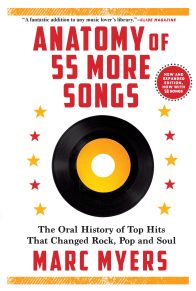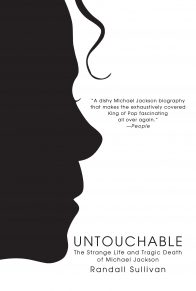“In these pieces . . . songwriters and performers speak in their own voices, edited from interviews with Myers, about one of their signature songs. Because of Myers’s skill as an interviewer, their pride and enthusiasm come blasting through. Each story is a pleasure to read and will deepen your listening experience . . . Myers bears down hard on these songs and the artists rise to the standards he sets.” —Anthony DeCurtis, New York Times Book Review
“Candid conversations with stars like Stevie Wonder, Keith Richards and Rod Stewart are collected in a new book called Anatomy of a Song . . . In the pre-digital age of analog recording, Myers discovered some remarkable examples of mechanical ingenuity. Two of my favorites: Kinks guitarist Dave Davies had just learned how to shave when he bought a new amp and decided to use a razor blade to slash the amp’s speaker cone. And when the Doors were told to shorten the seven-minute version of ‘Light My Fire’ for a single that would get more radio play, their producer Paul Rothchild ‘wrapped Scotch tape around the spindle holding the pickup reel, so the tape would turn a fraction faster’ . . . Myers is particularly good on the competition within bands and between them to produce the best possible songs . . . [A] splendid volume.” —Charles Kaiser, Guardian (UK)
“A music lover’s dream book.” —Michael Heaton, Cleveland Plain Dealer
“Not only . . . a first-rate playlist but a rich history of both the music industry and the baby boomer era.” —Los Angeles Times Book Review
“A deep look at songs that have had a lasting impact on our popular culture.” —Toronto Star
“Feature[ing] interviews with the artists, musicians, songwriters, and studio personnel involved with making songs that weren’t just considered big hits, but iconic pieces of art . . . a compilation that gradually forms a cohesive history of modern popular music . . . Anatomy of a Song‘s biggest strength lies in its rather diverse and impressive group of interviewees . . . An interesting read.” —PopMatters
“Who would’ve ever guessed the inspiration behind Gladys Knight’s soul-stirring ‘Midnight Train to Georgia’ was ’70s pinup queen Farrah Fawcett? That’s just one of the fascinating song histories revealed in the new book Anatomy of a Song.” —New York Post
“Anatomy of a Song . . . reads like a dream karaoke playlist. Not a dud in sight.” —Jillian Capewell, Huffington Post
“Myers . . . uncovers the fascinating backstories behind many legendary songs that changed the trajectory of music . . . Culling together anecdotal revelations about happy accidents, deliberately vague lyrical choices and unexpected lapses of confidence, the book manages to both demystify and humanize so many of its iconic subjects. . . . Anatomy of a Song is filled with surprises for music fans and aspiring songwriters alike.” —BMI Music
“Anatomy Of A Song . . . gets the lowdown on about forty years of hits straight from the artists’ mouths . . . It’s always cool to hear how the musical sausage gets made, especially when it’s made by geniuses in the field. But Myers also does an outstanding job of unearthing the moments of humor and heartbreak that accompanied the creation of these songs . . . It becomes evident that the heart counts for as much as the brain when it comes to the anatomies of these wonderful songs.” —Jim Beviglia, American Songwriter
“For a notable jazz writer, Marc Myers is noticeably free of the pretentious attitude that popular music belongs at the kids table. In his new book Anatomy of a Song . . . he takes an inclusive look at the stories behind 45 influential songs—an assortment of pop, rock, punk, folk, R&B and country staples—that form a hit parade stretching from 1952 to 1991 . . . A great holiday gift idea . . . By not playing favorites, [Myers] shows that the best jukeboxes are the ones with the widest range of choices.” —Julie Hinds, Detroit Free Press
“The short, sharp chapters breeze by like a particularly well-curated jukebox . . . Fast, fun and informative.” —Houston Press
“[A] great book.” —KISM
“Myers in the book seems a highly developed critic, fascinated by the technical aspects of musical production, and yet at the same time the least judgmental writer about music since the folding of Teen Beat magazine. He’s not trying to produce breathless fan writing or promotion; all the songs he examines have that inexplicable power of persistence, classics that have entered the permanent deposit of popular song, and none of them needs a sales agent . . . The critical ability of Marc Myers shows in his selection of topics and his persistence in hunting down the right people to talk about their songs. But his talent as a writer shows in his willingness to get out of the way and let them talk about their songs . . . Myers pushes his subjects to recollect what had really happened that day in the studio, that moment when the song first came to mind, that instant when the radio began to play it.” —Joseph Bottum, Washington Free Beacon
“A detailed look at 45 iconic popular songs . . . This will entice general readers and music lovers alike. In his introduction, Myers calls the book an ‘oral history jukebox,’ and popular-music fans everywhere will want to be ready with a pocketful of dimes.” —Rebecca Vnuk, Booklist
“A cultural history of the elusive hit single, focused on artists’ recollections and studio alchemy . . . His interview subjects are well-chosen, and the excerpts provide insight on the constantly changing technology and industry behind the hits . . . The book’s strength lies in thoughtful, wry reflections from artists including Elvis Costello, Jimmy Cliff, Stevie Wonder, Booker T. Jones, Dr. John, and Debbie Harry. An entertaining record of the soundtrack of the baby boomer era.”
—Kirkus Reviews
“Myers provides a new introduction to the songs, which were written between 1952 and 1991, setting each in its cultural context, as well as indicating its historical significance . . . Following these introductions, Myers then turns the mike over to the artists, writers, musicians, and producers behind each song, who tell us about the stories behind it . . . Music fans will enjoy the behind-the-songs stories.” —Publishers Weekly
“Who doesn’t like to listen to musicians tell their stories about the genesis of a song? Or to hear them laugh at the deep meaning that listeners often invest in it when for them it was, well, just a song about a breakup? Myers’ book has something for everyone.” —No Depression
“Countless fun facts dot Anatomy of a Song.” —Billboard
“Myers’ book succeeds as a collection because he reveals the paradox of popular music: the magical change that transpires once the personal becomes public. Whether he describes Otis Redding watching the ships come in, writing ‘(Sittin” on) The Dock of the Bay,’ or Dion DiMucci pounding tables in a basement party to create what later became ‘Runaround Sue,’ Myers shows us how these songwriters artfully, purposefully and sometimes accidentally tap into our secret yearning with their own . . . Perhaps the greatest gift of Anatomy of a Song is its range . . . This is a book that encourages you to go back into your record collection, to the hits you think you remember well.” —Las Vegas Weekly
“Building a song is like building anything else—it takes time and materials galore, inspiration and sweat. Building an iconic song that represents a time and place for millions of people is a phenomenon in and of itself. Anatomy of a Song by Marc Myers is a compelling compendium of behind-the-scenes shop talk that will excite even the most casual music geek . . . If you are a huge music fan, this book will become something of an encyclopedia that you will come back to time and again.” —Jana Siciliano, Bookreporter
“One could read Myers’ columns all day. For each of these 45 songs, there are 45 more that one could consume with rapt attention. Myers’ explorations dig to the heart of the artists, their motivations, and their creative processes . . . His work is archival. It is important. It is illuminating.” —Under the Radar
“This literary jukebox provides a backdrop of famous tracks by everyone from Janis Joplin and The Clash to Jimmy Cliff and Gladys Knight and the Pips.” —Family Circle
“Stories behind music’s biggest hits make for rocking good read . . . There are many great anecdotes in the book, the kind you’ll enjoy reading and perhaps recounting over a drink as one of the songs is played in your favorite watering hole.” —Winnipeg Free Press













